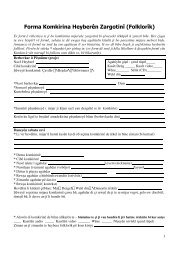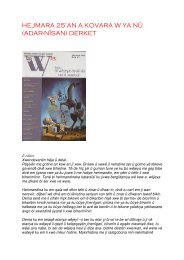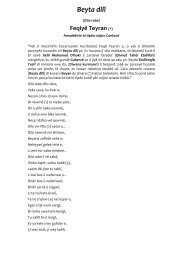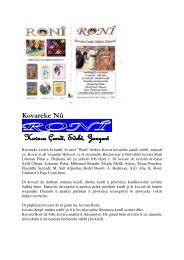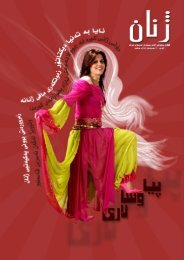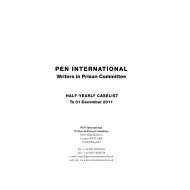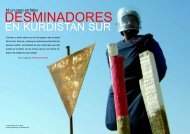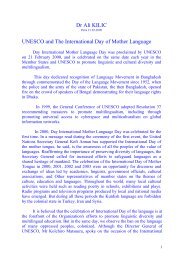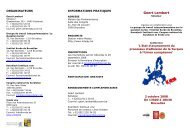The Kurds in Khorasan, North-east of Iran - Pen-Kurd
The Kurds in Khorasan, North-east of Iran - Pen-Kurd
The Kurds in Khorasan, North-east of Iran - Pen-Kurd
Create successful ePaper yourself
Turn your PDF publications into a flip-book with our unique Google optimized e-Paper software.
<strong>Khorasan</strong>i <strong>Kurd</strong>ish traditional social structure and network<strong>in</strong>g power’s ranks wereorganised accord<strong>in</strong>g to the follow<strong>in</strong>g hierarchy:Social Structure …………....…>……………. Network Power1- Greater tribe (Confederacy)…>……….…….ill-khan (Mir)2- Tribe (ill)……………….……>……………..ill-Beg (Khan)3- Clan (Tayfeh)….………….…>…………..…Beg (Kad-khoda)4- Sect (Toper)………………….>………..……Rih-gewir (senior person)5- Camp group (Obe / B<strong>in</strong>e)……>…………..…Sar-obe (Camp chief)6- Family (unit / tent /quw<strong>in</strong>)......>………….… Sare-male (family head)<strong>The</strong> only major <strong>Kurd</strong>ish confederacy <strong>in</strong> <strong>Khorasan</strong> was Chamishgazak confederacywhich its name was changed to Za’afaranlu confederacy, about 1760 AD (made up <strong>of</strong>about 32 tribes; 8 major plus 24 small tribes). Usually about 4 to 8 unit make an Obedepends on their livestock size.Ill-khan as head <strong>of</strong> <strong>Kurd</strong>ish confederacy had a strong political power and was <strong>in</strong>relat<strong>in</strong>g to central government. Ill-khan also was responsible for protect<strong>in</strong>g the Stateborders from warriors. Confederacy was a comb<strong>in</strong>e <strong>of</strong> some tribes as wider politicalorganization; an aff<strong>in</strong>ity was recognized with adjacent tribes such as the Kawanlu,Topkanlu, Kikanlu, Jalai, Maliwanlu and Qarachorlu as Za’afaranlu confederacy.<strong>The</strong>se political power rank<strong>in</strong>gs and pr<strong>in</strong>ciple were destroyed <strong>in</strong> Reza-shah time, 1920AD, wish<strong>in</strong>g to control, reorganize or disband nomad tribes.Tribal names are generally composed <strong>of</strong> an orig<strong>in</strong> followed by the suffix " Li " or " Lu" which implies " <strong>of</strong> " or " belong<strong>in</strong>g to ". Thus a tribe may acquire its name by afound<strong>in</strong>g father’s name, for <strong>in</strong>stance; the name Kavanlu (Kowanli / Kawanlu) comesafter Kava / Kawe, which is the name <strong>of</strong> Kava the blacksmith (621 BC) who is thecreator <strong>of</strong> Newroz and its fire festival celebration, 21st March on every years untiltoday.Alternatively some characteristic or nick name, for <strong>in</strong>stance such as Pahlavanlu (verystrong or athlete) might be rife <strong>in</strong>to the tribal name structure simply reflects the factthat tribal and village designations are frequently <strong>in</strong>terchangeable.Nowadays, the tribes <strong>in</strong> <strong>Khorasan</strong> are not hierarchically organised, unlike <strong>in</strong> formerone that each tribe had an organised structure with a head chief. <strong>Khorasan</strong>i <strong>Kurd</strong>ishtribes and clans are listed with their locations as follow<strong>in</strong>g. Remarks <strong>in</strong> parentheses<strong>in</strong>clude alternative tribal name. <strong>The</strong> language <strong>of</strong> them is <strong>Kurd</strong>ish dialect <strong>of</strong> Kormanji.12



